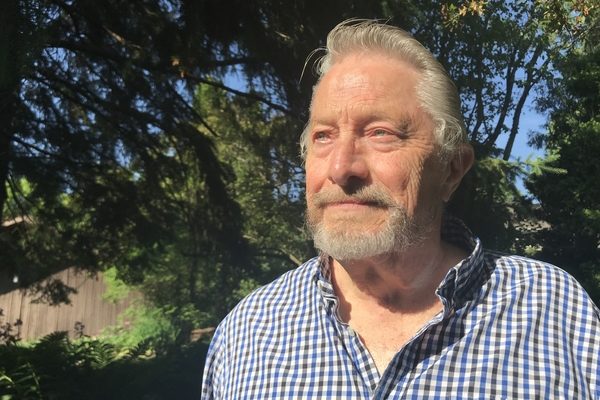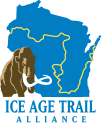By Sevie Kenyon, volunteer writer for the Ice Age Trail Alliance

The Ray Zillmer Award recognizes individuals whose work exemplifies the ideals that inspired the establishment of the Ice Age National Scenic Trail. This year, the award recipients are David Phillips and David Kinnamon, both of whom have steered the course of the Ice Age Trail Alliance’s history.
Finding a Way Through
Astonishing, really, how youthful experiences can shape character. “Since I was a little boy I’ve been enthusiastic about the outdoors,” says David Phillips. “I grew up in a small town in western Pennsylvania. We lived in a housing project and behind our house was a park. We were allowed to play in the park because mom could see us from the kitchen window.”
The trouble was, David could see the woods on the other side of a busy road from the park. Trees in the safety of the park were wonderful but the forbidden woods stirred the imagination and tickled his curiosity.
“I was fascinated with the trees on the other side of the road,” he says. “We found a culvert and were able to cross under the road. Even at six or seven years old, I think I understood the concept of the technicality.”

Finding a way through is the creative hallmark for earning David Phillips the Ray Zillmer Award, the highest honor given by the Ice Age Trail Alliance. The Ray Zillmer Award recognizes individuals whose work exemplifies the long-range, big-picture ideals that inspired and continue to inspire the establishment of the Ice Age Trail.
Following college and a stint in Peace Corps Africa, the journey from western Pennsylvania to Wisconsin was part design part happenstance. David came to Wisconsin to work on a farm in Lincoln County with plans going to California at the end of summer. But he found work at a youth correctional facility so he stayed.
Soon, David was hooked on the Ice Age Trail. Credit trail mentor and Northwoods Chapter Coordinator, Herb Schotz, with advanced inspiration and edification. “He explained the details,” David says. As is the case so often in life, one thing leads to another. David became more involved with trailbuilding and developing the human capital needed to make the Trail a living sustainable thing.
In the 1970s and 1980s, there were two non-profit organizations, explains Drew Hanson on the award form. There was an Ice Age Trail Council dedicated to activities such as trailbuilding and an Ice Age Park and Trail Foundation dedicated to finding money and allocating funds. Often, the two organizations were at cross purposes. As a leader on the Council, David led efforts to merge the organizations into a single, unified alliance.’
“The merger was a tense, big-picture process. Success was not assured. But Dave helped show the way. Thanks to his vision, thoughtfulness, steady hand and sometimes just the right words, Dave helped broker the successful merger of the two organizations in 1990. It was without question a major milestone in the history of the Ice Age Trail Alliance,” writes Hanson.
David has been there for many Ice Age Trail milestones. One he mentions concerns the very nature of the Trail itself. In the early stages of trail development, the prevailing philosophy was to make it a wilderness-based experience. David wasn’t so sure.
“The wilderness trail is nice to do. But this is Wisconsin and there are a lot of people who could connect to the Ice Age Trail,” David says. “I think it was when I was president the second time I wanted to change that philosophy. The idea was to connect people to the Trail and connect the towns and villages along the way.”
Now there are even designated Trail Communities: Cornell, Cross Plains, Delafield, Hartland, Janesville, Lodi, Manitowoc-Two Rivers, Milton, Slinger, St. Croix Falls, West Bend, Whitewater, and UW-Whitewater (a Trail Campus!), and more are in the hopper. David views this connection as a means for developing a constituency of people supportive and interested in the Trail.
“The trail rose up onto a perfectly formed esker, wending through the forest like a giant sleeping snake. I caught up on a grassy shelf above the river. To the north we could see the break in the moraine where some 12,000 years ago the melting glacial water breached an ice dam emitting a cataclysmic flood that gave birth to the valley and the modern Oconomowoc River. Again, I fell behind. I thought about those people who preceded me on this spot thousands of years ago. They witnessed the creation of this magnificent landscape. I can only see what they saw through my imagination.”
— David Phillips, journal entry, President’s Report, Summer 2001.
David would love to see the Trail completed one day. He has walked the majority of its distance and hopes one day much more of it is off road, in the woods. The Trail is much more polished and durable now than ever, he adds. Much of that is due to David’s ability for spotting a culvert to find a way through.
About the Author
Sevie Kenyon is a retired agricultural photographer and writer currently living in Oregon, Wisconsin. He is a member of the Rock County Chapter of the Ice Age Trail Alliance. When asked about his favorite place on the Ice Age Trail, Sevie will tell you “every step of it.” For more of Kenyon’s work, check out his photography and stories.

